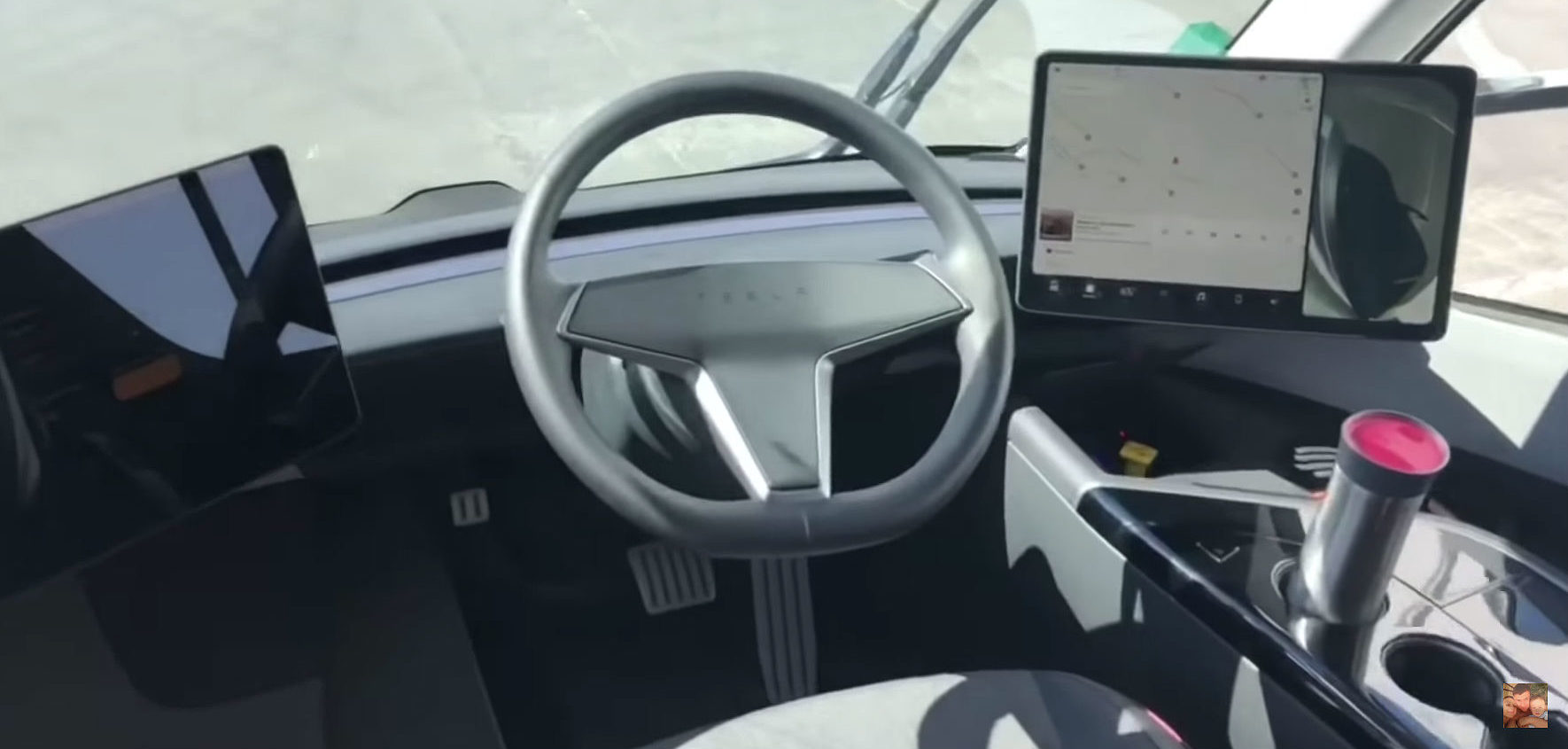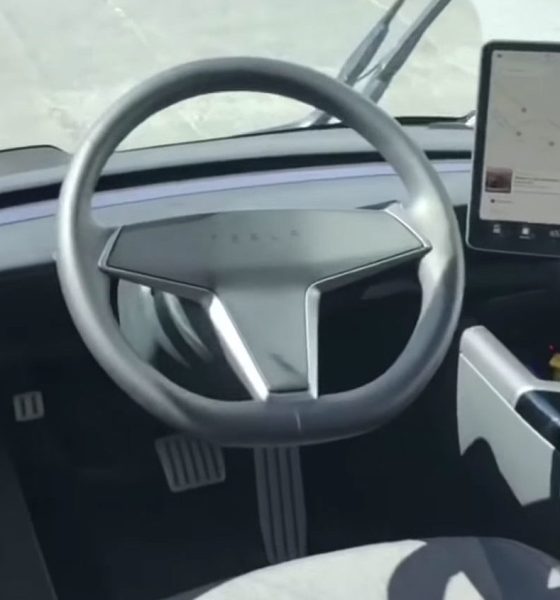

News
Tesla Semi cabin’s Model 3-inspired elements showcased in new video
A video featuring a rare look at the Tesla Semi’s cabin was recently uploaded on YouTube. As could be seen in the short clip, the all-electric long-hauler features some compelling design elements, from components inspired by the Model 3 to a mysterious pedal beside the vehicle’s brakes.
The Semi’s recent video was uploaded by Moldova-born YouTuber and truck enthusiast Andrew Black, who was able to get up close and personal with the all-electric long-hauler. The Tesla Semi in the video was hauling a trailer from Xtra Lease Trailers, suggesting that the truck was in a transport run when the footage was taken.
Immediately noticeable from the Tesla Semi’s cabin was how roomy and spacious it was. Even with the jumpseat for the passenger unfolded, the electric truck still has a very roomy feel. Upfront, several design elements pop up, the most notable of which is an air vent inspired by the Model 3. The Tesla Semi also features a clean, minimalistic, end-to-end dashboard that runs from one side of the vehicle to the other.
In a lot of ways, the Tesla Semi actually borrows some components from the Model 3. Apart from its end-to-end HVAC system, the Semi also uses the same electric motor as the compact electric car (it has four Model 3-derived electric motors). The Semi is fitted with what appears to be the door handles of the Model 3, as well as dual touchscreen controls that invoke the compact electric car’s landscape-oriented center touchscreen. The size of the Semi’s two touch panels have not been mentioned by Tesla, but based on Black’s recent video, it seems safe to assume that its dual displays are also 15-inch panels.
One thing that grabs the attention from the video, however, was a rather mysterious pedal that could be seen near the 1-minute mark. As the camera was being panned across the Tesla Semi’s cabin, the all-electric truck’s accelerator and brake pedals could be seen prominently. To the left of the brakes, however, was seemingly another pedal. Unlike the dead pedal found in the Model S, Model X, and Model 3, the third pedal in the Semi was rather small, and it looked functional. Some members of the r/TeslaMotors subreddit have weighed in on the mysterious pedal, with a number suggesting that it could be a mechanical parking brake.
Just like the Model 3, the Tesla Semi has the potential to be an incredibly disruptive vehicle. The electric truck is a Class 8 truck equipped with four Model 3-derived electric motors, which enable it to accelerate from 0-60 mph in 5 seconds flat without cargo. With a full 80,000-lb load, the Semi is still capable of hitting highway speed in 20 seconds, far quicker than comparable diesel-powered semi-trailers.
The Tesla Semi is currently being tested and driven across the United States. Just recently, the electric long-hauler was spotted driving over the Golden Gate Bridge on its way to Santa Rosa, CA. According to Tesla’s Tesla’s VP of Truck Programs Jerome Guillen in his LinkedIn profile, the Semi was headed to Santa Rosa to visit some local customers.
Tesla CEO Elon Musk and CTO JB Straubel revealed during the Q1 2018 earnings call that the Semi currently has around 2,000 reservations from businesses within and outside the United States. In the United States alone, several high-profile companies have already placed orders for the electric truck, including PepsiCo, FedEx, and Anheuser-Busch. Outside the United States, grocery chain ASKO from Norway has placed reservations for the long-hauler, as well as waste management conglomerate Bee’ah from the Middle East, among others.
Watch Andrew Black’s video of the Tesla Semi’s cabin below.

Elon Musk
Elon Musk’s X will start using a Tesla-like software update strategy
The initiative seems designed to accelerate updates to the social media platform, while maintaining maximum transparency.

Elon Musk’s social media platform X will adopt a Tesla-esque approach to software updates for its algorithm.
The initiative seems designed to accelerate updates to the social media platform, while maintaining maximum transparency.
X’s updates to its updates
As per Musk in a post on X, the social media company will be making a new algorithm to determine what organic and advertising posts are recommended to users. These updates would then be repeated every four weeks.
“We will make the new 𝕏 algorithm, including all code used to determine what organic and advertising posts are recommended to users, open source in 7 days. This will be repeated every 4 weeks, with comprehensive developer notes, to help you understand what changed,” Musk wrote in his post.
The initiative somewhat mirrors Tesla’s over-the-air update model, where vehicle software is regularly refined and pushed to users with detailed release notes. This could empower developers and users to better understand and contribute to X’s feed mechanics, addressing common complaints about visibility and bias.
xAI and X
X, formerly Twitter, has been acquired by Elon Musk’s artificial intelligence startup, xAI last year. Since then, xAI has seen a rapid rise in valuation. Following the company’s the company’s upsized $20 billion Series E funding round, estimates now suggest that xAI is worth tens about $230 to $235 billion. That’s several times larger than Tesla when Elon Musk received his controversial 2018 CEO Performance Award.
As per xAI, the Series E funding round attracted a diverse group of investors, including Valor Equity Partners, Stepstone Group, Fidelity Management & Research Company, Qatar Investment Authority, MGX, and Baron Capital Group, among others. Strategic partners NVIDIA and Cisco Investments also continued support for building the world’s largest GPU clusters.
News
Tesla FSD Supervised wins MotorTrend’s Best Driver Assistance Award
The decision marks a notable reversal for the publication from prior years, with judges citing major real-world improvements that pushed Tesla’s latest FSD software ahead of every competing ADAS system.

Tesla’s Full Self-Driving (Supervised) system has been named the best driver-assistance technology on the market, earning top honors at the 2026 MotorTrend Best Tech Awards.
The decision marks a notable reversal for the publication from prior years, with judges citing major real-world improvements that pushed Tesla’s latest FSD software ahead of every competing ADAS system. And it wasn’t even close.
MotorTrend reverses course
MotorTrend awarded Tesla FSD (Supervised) its 2026 Best Tech Driver Assistance title after extensive testing of the latest v14 software. The publication acknowledged that it had previously criticized earlier versions of FSD for erratic behavior and near-miss incidents, ultimately favoring rivals such as GM’s Super Cruise in earlier evaluations.
According to MotorTrend, the newest iteration of FSD resolved many of those shortcomings. Testers said v14 showed far smoother behavior in complex urban scenarios, including unprotected left turns, traffic circles, emergency vehicles, and dense city streets. While the system still requires constant driver supervision, judges concluded that no other advanced driver-assistance system currently matches its breadth of capability.
Unlike rival systems that rely on combinations of cameras, radar, lidar, and mapped highways, Tesla’s FSD operates using a camera-only approach and is capable of driving on city streets, rural roads, and freeways. MotorTrend stated that pure utility, the ability to handle nearly all road types, ultimately separated FSD from competitors like Ford BlueCruise, GM Super Cruise, and BMW’s Highway Assistant.
High cost and high capability
MotorTrend also addressed FSD’s pricing, which remains significantly higher than rival systems. Tesla currently charges $8,000 for a one-time purchase or $99 per month for a subscription, compared with far lower upfront and subscription costs from other automakers. The publication noted that the premium is justified given FSD’s unmatched scope and continuous software evolution.
Safety remained a central focus of the evaluation. While testers reported collision-free operation over thousands of miles, they noted ongoing concerns around FSD’s configurable driving modes, including options that allow aggressive driving and speeds beyond posted limits. MotorTrend emphasized that, like all Level 2 systems, FSD still depends on a fully attentive human driver at all times.
Despite those caveats, the publication concluded that Tesla’s rapid software progress fundamentally reshaped the competitive landscape. For drivers seeking the most capable hands-on driver-assistance system available today, MotorTrend concluded Tesla FSD (Supervised) now stands alone at the top.
News
Elon Musk’s Grokipedia surges to 5.6M articles, almost 79% of English Wikipedia
The explosive growth marks a major milestone for the AI-powered online encyclopedia, which was launched by Elon Musk’s xAI just months ago.

Elon Musk’s Grokipedia has grown to an impressive 5,615,201 articles as of today, closing in on 79% of the English Wikipedia’s current total of 7,119,376 articles.
The explosive growth marks a major milestone for the AI-powered online encyclopedia, which was launched by Elon Musk’s xAI just months ago. Needless to say, it would only be a matter of time before Grokipedia exceeds English Wikipedia in sheer volume.
Grokipedia’s rapid growth
xAI’s vision for Grokipedia emphasizes neutrality, while Grok’s reasoning capabilities allow for fast drafting and fact-checking. When Elon Musk announced the initiative in late September 2025, he noted that Grokipedia would be an improvement to Wikipedia because it would be designed to avoid bias.
At the time, Musk noted that Grokipedia “is a necessary step towards the xAI goal of understanding the Universe.”
Grokipedia was launched in late October, and while xAI was careful to list it only as Version 0.1 at the time, the online encyclopedia immediately earned praise. Wikipedia co-founder Larry Sanger highlighted the project’s innovative approach, noting how it leverages AI to fill knowledge gaps and enable rapid updates. Netizens also observed how Grokipedia tends to present articles in a more objective manner compared to Wikipedia, which is edited by humans.
Elon Musk’s ambitious plans
With 5,615,201 total articles, Grokipedia has now grown to almost 79% of English Wikipedia’s article base. This is incredibly quick, though Grokipedia remains text-only for now. xAI, for its part, has now updated the online encyclopedia’s iteration to v0.2.
Elon Musk has shared bold ideas for Grokipedia, including sending a record of the entire knowledge base to space as part of xAI’s mission to preserve and expand human understanding. At some point, Musk stated that Grokipedia will be renamed to Encyclopedia Galactica, and it will be sent to the cosmos.
“When Grokipedia is good enough (long way to go), we will change the name to Encyclopedia Galactica. It will be an open source distillation of all knowledge, including audio, images and video. Join xAI to help build the sci-fi version of the Library of Alexandria!” Musk wrote, adding in a later post that “Copies will be etched in stone and sent to the Moon, Mars and beyond. This time, it will not be lost.”









